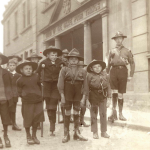40 Years ago today was a momentous day in the human rights journey of disabled people. Up until that point it was generally expected that disabled people, who needed a level of care support, would spend their lives in institutions.
The entrenched inequality that disabled people faced ignited a small cohort of disabled people to form the Union of the Physically Impaired Against Segregation (UPIAS). This movement was founded by Paul Hunt in 1972 who was at that time was a resident in a Leonard Cheshire home. Other key members were Vic Finkelstein and Maggie and Ken Davis.
Vic Finkelstein, originally from South Africa and an anti-apartheid campaigner, was the first person to introduce the idea of disability as a capitalist creation. He understood disability to have a social relationship in which disabled people are oppressed. He wanted to overturn the concept of disability as purely a medicalised condition. The concept of ‘The Social Model of Disability’ was born.
Accentuate follows the Social Model principal, which means that we believe disabled people are disabled by the barriers they face rather than a medical condition. So, in other words, as a wheelchair user, if I have a car I can get in to, ramps into buildings where there are steps and lifts where there are stairs, then I am no longer disabled by my medical condition; as it is my environment and the attitudes of others that ‘disable’ me.
Equally radical was the need for disabled people to take back control of their own lives and in particular emancipate themselves from institutions which were really no better than prisons.
This understanding of disability as a social construct was the radical concept at the heart of UPIAS. It was revolutionary to create such a political movement, but equally radical was the need for disabled people to take back control of their own lives and in particular emancipate themselves from institutions which were really no better than prisons.
Pioneering independent living
Having first hand experience of this injustice Maggie and Ken Davis went about trying to change the very system that wanted to keep them from living independently. In September 1972 they decided to establish a cooperative that would look to buy land, commission architects and design their own housing scheme. This was to be known as the Grove Road Housing Scheme.
Four years later, on 13th September 1976, Maggie and Ken moved into their own home, which they had designed specifically to enable them to have independence. A kitchen sink was brought in from Sweden, lowered kitchen work surfaces and ceiling hoists allowed access from bed to chair to bathroom. It was the way they approached the design process, working closely with the architects, ensuring the building and the adaptations met their needs, which meant they were no longer reliant on non-disabled people helping them.
Maggie and Ken were told time and time again by ‘the professionals’ that they couldn’t do it and it wouldn’t work. It was a hard won battle to prove them wrong.
Maggie and Ken were told time and time again by ‘the professionals’ that they couldn’t do it and it wouldn’t work. It was a hard won battle to prove them wrong. At this moment in time when we are hearing the Paralympic slogan ‘yes I can’ perhaps we need to reflect more widely and think about the daily battles for rights that disabled people have spearheaded over the last 40 years. Maggie and Ken paved the way for me to live in my own home, but I am one of the disabled people who used to receive Independent Living Fund money to pay for support in my home. I cherish my independence. Let’s learn from history and ensure that the fight Maggie and Ken led was not in vain and our rights to equal treatment and opportunities are protected for the next 40 years.
Maggie’s legacy at RIBA and the V&A
History of Place provides an opportunity for us to share and protect this valuable heritage. We are currently working with the V&A London and RIBA to catalogue and safe guard Maggie’s wonderful archive material.










